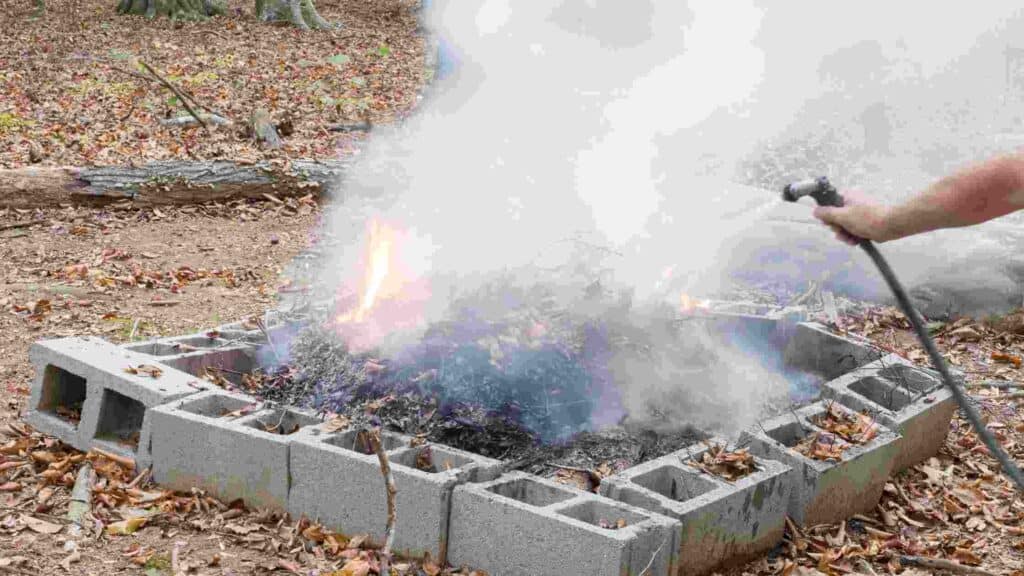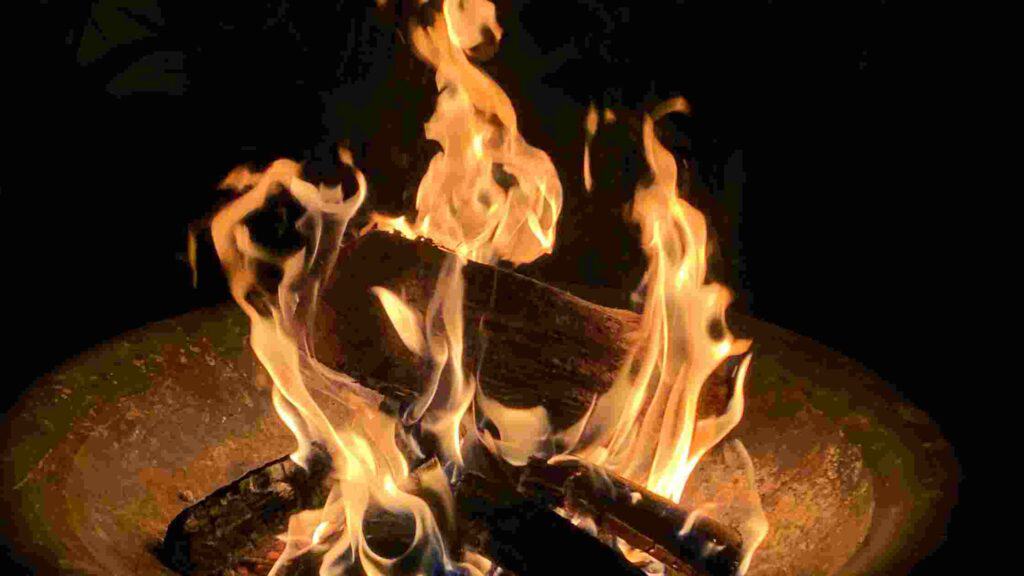Many people enjoy gathering around a fire pit during the cooler months to roast marshmallows, enjoy a warm drink, and spend time with friends and family. However, it is important to know how to put out a fire pit to prevent accidental fires and injuries.
There are several methods to extinguish a fire pit, including using water, sand, or soil. It is important to never leave a fire pit unattended and to have a source of water nearby in case of emergencies.
Additionally, it is important to check the weather conditions before starting a fire to ensure that there are no fire restrictions or high winds that could spread the fire.
By following proper fire safety guidelines and knowing how to properly extinguish a fire pit, individuals can enjoy their time around the fire pit while also keeping themselves and their surroundings safe.
Safety Precautions
When it comes to using fire pits, safety should always be the top priority. Here are some important safety precautions to keep in mind when using a fire pit:
Before Extinguishing
Before attempting to extinguish a fire pit, it’s important to take a few steps to ensure safety:
- Check the Wind Conditions: Always check the wind conditions before starting a fire in your fire pit (learn how to start a fire in a fire pit). If it’s too windy, it’s best to wait for calmer conditions. Wind can cause fire embers to spread, which can be dangerous.
- Remove Flammable Objects: Remove any flammable objects from the area around the fire pit. This includes things like dry leaves, paper, and other debris. Clearing an area of flammable objects can help prevent the fire from spreading.
- Prepare Extinguishing Materials: Before starting a fire, prepare extinguishing materials like a bucket of water, sand, or a fire extinguisher. These materials should be easily accessible and ready to use in case of an emergency.
Protective Equipment
Protective equipment can help prevent injuries when using a fire pit. Here are some items that can be useful:
- Fire Gloves: Fire gloves can protect your hands from burns when handling hot logs or embers. These gloves are made of heat-resistant materials and are designed to withstand high temperatures.
- Eye Protection: Eye protection can help prevent injuries from flying embers or ash. Safety goggles or glasses can protect your eyes from sparks and debris.
- Fire Retardant Clothing: Fire retardant clothing can provide an extra layer of protection when using a fire pit. These clothes are made of materials that are resistant to flames and can help prevent burns.
By taking these safety precautions and using protective equipment, you can help ensure a safe and enjoyable experience when using a fire pit (be sure to check out our top pick for the best clay chiminea for your outdoor space).
3 Extinguishing Methods

When it comes to putting out a fire pit, there are several methods available. The most common methods include water dousing, sand smothering, and fire blankets.
1. Water Dousing
Water dousing is the most common method of extinguishing a fire pit. It involves pouring water over the fire until it is completely out.
It is important to use enough water to completely extinguish the fire and prevent any smoldering embers from reigniting the fire. It is recommended to use a large bucket of water or a garden hose to extinguish the fire.
2. Sand Smothering
Sand smothering is another effective method of extinguishing a fire pit. It involves pouring sand over the fire until it is completely covered.
The sand will cut off the oxygen supply to the fire, causing it to die out. It is important to use enough sand to completely cover the fire and prevent any smoldering embers from reigniting the fire.
3. Fire Blanket
A fire blanket is a specially designed blanket that is used to extinguish fires. It is made of fire retardant material and is designed to smother the fire by cutting off the oxygen supply. To use a fire blanket, simply place it over the fire and leave it in place until the fire is completely out.
It is important to note that each of these methods has its own advantages and disadvantages. For example, water dousing is effective but can be messy and may cause damage to the fire pit.
Sand smothering is effective and less messy but can be heavy and difficult to handle. Fire blankets are effective but may not be suitable for larger fires.
It is recommended to choose the method that is best suited for the situation and to always follow proper safety precautions when putting out a fire pit.
Post-Extinguishing Procedures
After the fire pit has been completely extinguished, there are a few post-extinguishing procedures that must be followed to ensure safety and prevent any potential fire hazards.
Ash Disposal
The ashes left behind after the fire has been put out can still retain heat and cause a fire if not disposed of properly (check out the article: How hot does a fire pit get?). It is important to wait at least 24 hours after extinguishing the fire before attempting to dispose of the ashes.
Once the ashes have cooled down completely, they can be disposed of in a metal container with a tight-fitting lid. This will prevent any wind from blowing the ashes away and causing a fire.
Fire Pit Inspection
It is important to inspect the fire pit after every use to ensure that it is still in good condition. Check for any cracks or damage to the fire pit bowl, legs, or screen. Any damage to the fire pit can cause a potential fire hazard and should be repaired or replaced immediately.
In addition to inspecting the fire pit, it is also important to check the surrounding area for any potential fire hazards.
Make sure there are no flammable materials, such as dry leaves or paper, near the fire pit. Also, ensure that the fire pit is at least 10 feet away from any structures or trees.
By following these post-extinguishing procedures, you can ensure the safety of your outdoor area and prevent any potential fire hazards.
Preventing Future Fires
Fire pits are a great way to enjoy the outdoors, but they can also pose a risk if not used and maintained properly. To prevent future fires, it’s important to follow proper fire pit maintenance and safe fire extinguishing practices.
Proper Fire Pit Maintenance
Regular maintenance of your fire pit can help prevent future fires. Here are some tips to keep your fire pit in good condition:
- Clean out ashes and debris after each use. This will prevent buildup that can ignite and cause a fire.
- Check for any cracks or damage to the fire pit. If you notice any damage, repair or replace the fire pit before using it again.
- Keep the area around the fire pit clear of flammable materials such as leaves, brush, and other debris.
Safe Fire Extinguishing Practices
Knowing how to properly extinguish a fire pit is crucial to preventing future fires. Here are some safe fire-extinguishing practices to follow:
- Stop adding fuel to the fire pit about an hour before you plan to extinguish it. This will give the fire time to burn down.
- Use a fire extinguisher or a bucket of sand to extinguish the fire if it gets out of control.
- If using water to extinguish the fire, pour water evenly over the fire to avoid hot spots. Be sure to use enough water to fully extinguish the fire.
- Never leave a fire pit unattended while it is still burning.
Legal Considerations

When it comes to fire pits, there are some legal considerations that you should be aware of. In this section, we will cover some of the most important ones.
Local Fire Regulations
Before you start using your fire pit, it is important to check your local fire regulations. Many cities and towns have specific rules and regulations regarding fire pits, and it is important to follow them to avoid fines or other penalties (read more: Can you have a fire in your backyard?).
Some common regulations include:
- Fire pit location: Fire pits should be placed at least 15 feet away from any combustible structure or material, such as a fence or tree.
- Supervision: Someone should be present at all times while the fire pit is in use.
- Extinguishing materials: You should have a fire extinguisher, garden hose, or other extinguishing materials on hand in case of an emergency.
Environmental Protection Laws
In addition to local fire regulations, there may also be environmental protection laws that you need to follow. For example, some areas have burn bans during times of high fire danger, and you may not be allowed to use your fire pit during these times.
It is also important to be mindful of the materials you are burning in your fire pit. Burning certain materials, such as treated lumber or plastics, can release harmful chemicals into the air and harm the environment.
Stick to burning natural materials like wood, and avoid burning anything that is not meant to be burned.
By following local fire regulations and environmental protection laws, you can enjoy your fire pit safely and responsibly.
Frequently Asked Questions
What is the safest method to extinguish a fire pit?
The safest method to extinguish a fire pit is to use water. Pour water over the fire until it is completely out.
Make sure to use enough water to fully saturate the fire pit and surrounding area. Stir the ashes and embers with a shovel or stick to ensure that all the embers are extinguished.
Can I use a lid or snuffer to put out a fire pit, and how does it work?
Yes, you can use a lid or snuffer to put out a fire pit. A lid or snuffer is placed over the fire pit to cut off the oxygen supply and suffocate the flames. This method is effective in putting out the fire, but it is not as safe as using water.
What are the steps to put out a fire pit without using water?
To put out a fire pit without using water, you can cover the fire with sand or dirt. Spread a layer of sand or dirt over the fire pit until the flames are completely smothered. Use a shovel to stir the sand or dirt to ensure that all embers are extinguished.
How long should I wait before leaving a fire pit unattended after extinguishing it?
After extinguishing a fire pit, it is important to wait until the ashes are completely cool before leaving it unattended. This can take several hours, so it is best to plan ahead and extinguish the fire well before you plan to leave.
Is it better to let a fire pit burn out naturally or to extinguish it manually?
It is safer to extinguish a fire pit manually rather than letting it burn out naturally. Letting a fire pit burn out naturally can take a long time and can result in hot embers that can reignite and cause a fire.
What are the risks of using water to extinguish a fire pit and what alternatives exist?
Using water to extinguish a fire pit can create steam and hot ash, which can cause burns or start a fire in nearby materials. If using water is not an option, you can use sand, dirt, or a fire extinguisher to put out the fire.
